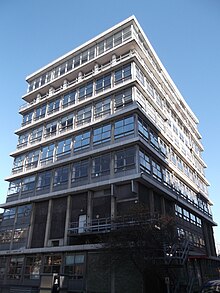 The Thom Building from the Banbury Road. | |
| Established | 1908 |
|---|---|
| Head of Department | Prof Ronald Roy |
| Location | , 51°45′35″N 1°15′34″W / 51.75972°N 1.25944°W |
| Campus | Keble Road Triangle |
| Website | www |

The Department of Engineering Science is the engineering department of the University of Oxford.[1] It is part of the university's Mathematical, Physical and Life Sciences Division. The department was ranked third best institute in the UK for engineering in the 2021 Research Excellence Framework.[2]
It is principally located on a triangular plot formed by Banbury Road to the west, Parks Road to the east and Keble Road to the south. The main building is the tall 1960s Thom Building that dominates the local landscape, especially the view from the University Parks to the east. Further lower buildings have been added to the north since then. The department shares buildings with the Department of Materials.
The department is based in the Thom Building, built in 1960, which houses two main lectures theatres, four floors of teaching, research and technical support laboratories, core administration offices and a student study area. The adjacent array of four interconnected buildings house departmental professor and postgraduate research space, some of which is shared with the Department of Materials. The department also maintains satellite facilities in a number of locations throughout the city. This includes the Old Road Campus Building, which houses the Institute of Biomedical Engineering, the Southwell Building (the Oxford Thermofluids Institute), Eagle House (the Oxford Man Institute for Quantitative Finance), the George Building (the Oxford Robotics Institute), and Begbroke Science Park (the Institute for Advanced Technology building).[citation needed]

The department was originally established in 1908 with the appointment of the first professor of engineering science at Oxford, Frewen Jenkin,[3] grandfather of Lord Jenkin of Roding. The Jenkin Building is named after him. On 2 February 1909, the Honour School of Natural Science (Engineering Science) was formally instituted by a Statute of Oxford University.[3] The school was initially located at 6 Keble Road, on the south side of what is now known as the Keble Road Triangle, part of the Oxford University Science Area. The main part of the department has remained and expanded at this location to the present day.[citation needed]
The Thom Building, built in 1963, is named after Alexander Thom (1894–1985), a Scottish engineer who was also a professor of engineering at Oxford. The adjacent Holder Building followed in 1976.[citation needed]
The department celebrated its centenary in 2008 and Lord Jenkin acted as its patron.[4]
There have been approximately 40 spin-offs from research done in the Department of Engineering Science. These companies operate in the medical, biotech, energy, transport, instrumentation, materials, nanotech, optics, robotics, and information technology spaces. The list includes PowderJect Pharmaceuticals, YASA, OrganOx, First Light Fusion, Oxsonics, Oxbotica, Sensyne Health, OxVent, Mind Foundry[5] and Opsydia.
The intake of students into the department is between 160 and 170 annually.[6] The department offers a general engineering course, where students only specialise in one of six areas in their third and fourth years of their Masters in Engineering degree (MEng). These specialisations are:[7]
Students can also choose to follow an Engineering, Entrepreneurship and Management (EEM) pathway in the third and fourth years of their degree. This option is taught in coordination with the Saïd Business School.[citation needed]
The Department of Engineering Science carries out research in the following areas:
The department is home to five research institutes:
The research degrees offered by the department are MSc(R), DEng and DPhil.[9] The department has approximately 500 postgraduate research students.
The department was ranked third among UK engineering departments in 2021 Research Excellence Framework (REF), having previously ranked first in 2014.
| Assessment year | GPA | National ranking |
|---|---|---|
| 2021[2] | 3.67 | 3 |
| 2014[2] | 3.53 | 1 |